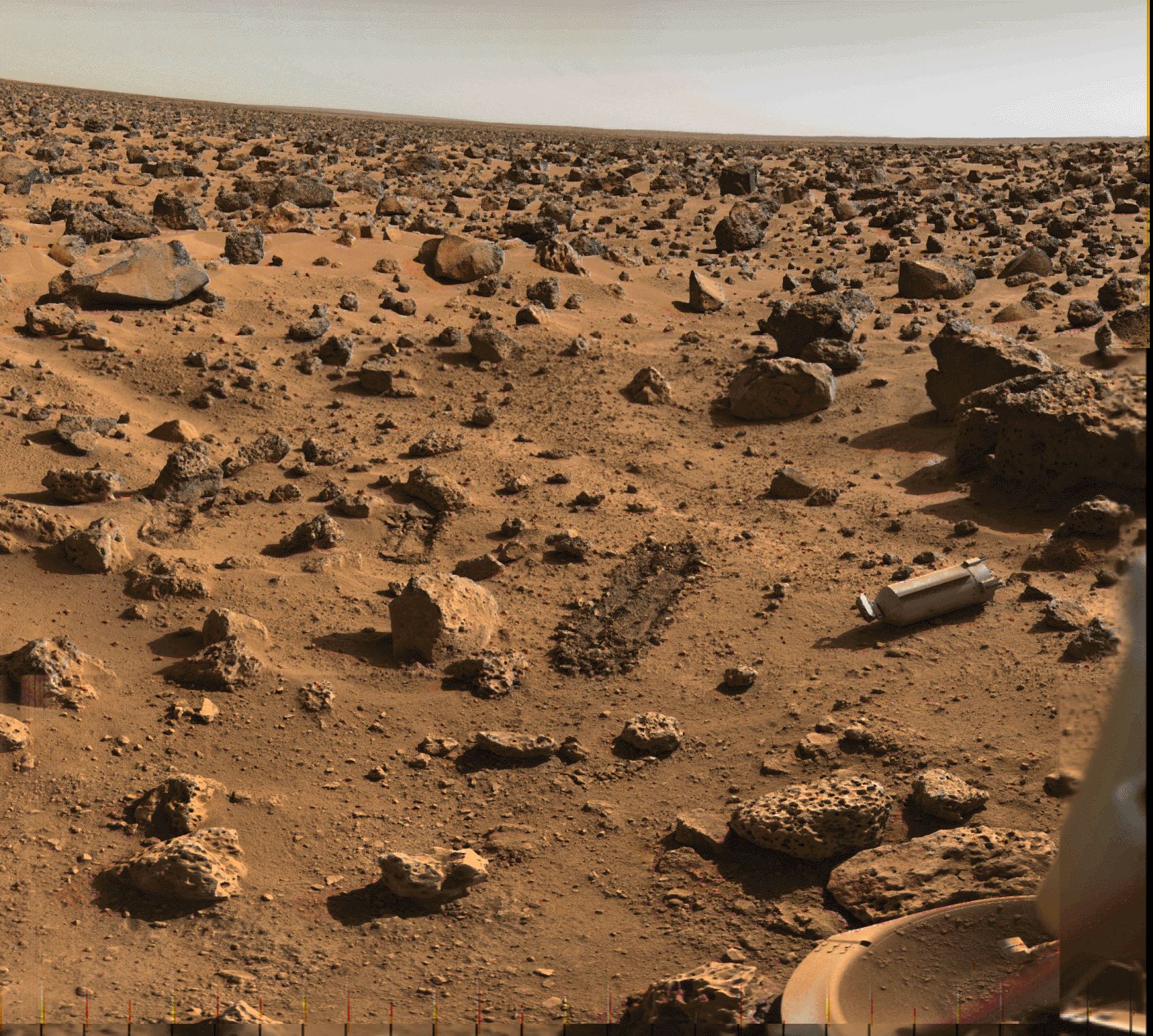= ASTRONAUTICAL EVOLUTION =
Issue 94, 1 September 2013 – 44th Apollo Anniversary Year
=============== AE ===============
Elysium, Earth; Elysium, Mars
Stephen Ashworth, Oxford, UK
Elysium station, near Earth
Some thoughts on the new blockbuster space movie, Elysium, directed, produced and written by Neill Blomkamp.

The movie begins with a cliché situation: Earth is overcrowded with poor people living in a hellish slum landscape, while the rich have moved to a space station, Elysium, in low Earth orbit. The rich/poor contrast is reminiscent of similar scenes at the start of Fritz Lang’s Metropolis. But the reference is intended to be to the present day United States: the poor speak Spanish; the rich, English and French.
From a distance the station is a single-wheel version of the great rotating double wheel from 2001: A Space Odyssey. The roof has been taken off so that the camera can zoom in from space and swoop low over the idyllic suburban landscape of spacious villas nestling among lavish gardens and swimming pools, resembling paintings of a Stanford torus type of O’Neill colony. Shuttles from Earth can land directly on the lawns of the billionaire class, yet strangely the atmosphere does not leak away.
See an image at space.com, where Dave Brody makes the point that the whole purpose of O’Neill’s space colony construction was to enrich Earth’s populations through cheap solar energy from space. In Elysium there’s not a power satellite in sight. But of course a planet full of peace and prosperity does not make for the sort of drama you need to drive a major movie script.
Women will be unhappy with the portrayal of the sexes. The male characters are mostly grimy, muscle-bound fighting machines, including the hero Max (a shaven-headed Matt Damon), and the two main antagonists augment their strength further with exoskeletons bolted crudely into their arms and shoulders. The other significant male character is a standard-issue corporate villain and heartless oppressor of the working class.
The women, on the other hand, are limited to a wicked witch of a security chief (played icily by Jodie Foster of Contact fame), a pretty damsel in distress with a little girl dying of leukaemia, and a wise old woman who appears in the flashbacks to the two main characters’ childhood. So Elysium wins no awards for subtlety of characterisation.
Robots are everywhere, appearing particularly as fairly indestructible and pretty vicious police officers. They serve, not so much the humans, as the mainframe that runs Elysium itself. This looks to me quite realistic: there will be anthropoid robots in 50 years time (the story is actually set 141 years in the future) and they could well be used for law-enforcement. But they won’t have the flexibility or understanding of humans, and certainly won’t have turned into godlike hyper-intelligences.
The degree of surveillance is another plausible glimpse into the future: wherever you are, there’s a camera (visible light or infra-red) watching you and a computer file with your details at the ready. But the present-day ubiquitous presence of consumer electronics has been abolished in the future of Elysium: nobody on Earth seems to have an iPhone any more. This strikes me as another cliché: in order to have a civilisation that can build a technical marvel like Elysium there has to be a sophisticated underlying mass market for high-tech products, I think.
Importantly, the story has an upbeat ending, and for this I think one can forgive its crude division of everybody into the extremely rich and the extremely poor, its sexual stereotyping, and its occasional reliance on technical miracles (such as shuttles which can fly into orbit on a couple of gallons of fuel).
Three and a half stars out of five, I’d give it.
Elysium Planitia, Mars
The real Elysium that any of us first think of when we hear the name is a 4000-km wide plain surrounding the 5-km high martian volcano Elysium Mons.

How might we live in Elysium Planitia? An e-mail correspondence on the pros and cons of shell-world terraforming as opposed to paraterraforming has forced me to face the issues.
The bottom line is this: concepts for living on Mars and similar worlds divide into global and non-global.
Global concepts involve terraforming in one way or another. The first to be studied was terraforming itself, which involves warming the planet, releasing CO2 to raise the atmospheric pressure, introducing hardy microorganisms and so on, with the object of ultimately replicating the surface environment of Earth for human habitation of another world.
In 1992 Richard L.S. Taylor introduced an alternative, which he called paraterraforming, in which worldhouses hundreds of km across but only between 1 and 3 km high are constructed and ultimately linked up to enclose most of the planetary surface (not including Elysium Mons or the giant volcanoes of Tharsis, which rise too high to be roofed over). A major motivation was to limit the amounts of atmospheric gases required (Mars may or may not lack sufficient nitrogen for an Earth-analogue gravity-bounded atmosphere, and smaller worlds will certainly lack both the volatiles inventories and the gravity to hold on to them in gaseous form).
Finally, in 2009, Ken Roy and collaborators proposed a method of constructing what they called shell worlds, and which by analogy I shall call shellterraforming. Like Taylor’s worldhouses, shellterraforming encloses the planet under an artificial roof, but constructs this roof over the entire surface before inflating it. There is another important difference: Taylor imagined an extremely thin roof (on the order of a millimetre thick, so far as I have been able to establish), which would be forced by the internal pressure into a state of extreme tension. But Roy’s shells would be thick enough to balance the internal pressure with their own weight.
When one contemplates the 144 million square km of the surface of Mars – vast plains, volcanoes, canyons, crater highlands, dune fields, chaoses – all these terraforming concepts come across as grandiose in the extreme. Yet the motivation is very simple: it is to create a biosphere, habitable by human beings, which like that of Earth is self-regulating and self-perpetuating. This demands a global scale in which some regions experience day, others night, some summer, others winter, in order to drive global air movements and daily and seasonal biorhythms – the Biosphere 2 project taken to its logical conclusion.
Will Mars one day be terraformed by some global scale project? However one imagines it, such a project demands time periods of millennia or more, and extremely large allocations of power and industrial infrastructure.
What this tells me is that, before Mars can be terraformed, large human populations will already live in space, on the Moon and no doubt already on Mars itself, in small-scale habitats whose life-support systems are not self-regulating in the sense that Earth’s is. They will be highly mechanised, with ubiquitous computer systems monitoring and adjusting lighting, heating, pressure, temperature, atmospheric consistuents, water salinity, microbial species and so on.
Therefore by the time that terraforming becomes a realistic possibility, the need to emulate the “natural” functioning of Earth’s biosphere will long have been bypassed. People will have been living for generations in planetary and space colonies which from a life-support point of view are simply enlarged spacecraft.
I envisage an architecture of large buildings on Mars, enclosures with dimensions on the order of hundreds of metres to a few kilometres with a ceiling height between 100 and 200 metres. Why does the ceiling need to be higher? Only to emulate Earth weather, which will not be needed.
The roofs will be 5 to 10 metres thick, both to balance the internal pressure and to largely screen out the incoming cosmic radiation. They will be built of huge slabs of locally produced glass, perhaps set into a steel frame, also locally manufactured. A number of different designs are possible, and the best ones are those which transfer all the internal atmospheric loads into compressive loads which are grounded in the surface of the planet: in this way they will differ from space colonies, whose structures are inevitably in tension from both internal pressure and rotation.
Our descendants will live on Mars as martians, not as earthlings. It will be different from Earth: there will be no blue sky and no martian seas. Elysium will remain a dry plain; it will not be flooded again as part of a northern ocean, even though it may once have been in the distant past.
While humans will adapt Mars to support them, they will also adapt themselves to be supported there. Only on Earth will people ever breathe the air and drink the water that a planetwide “nature” has recycled for them; elsewhere the very concept of nature will be redefined as the recycling machinery of industrial infrastructure.
Elysium, Mars, will support its inhabitants in the same way as Elysium, low Earth orbit, and nobody will worry about the fact that this is different from the ancestral biospherical system on Earth’s surface, any more than a young adult regrets living without his or her mother’s milk.